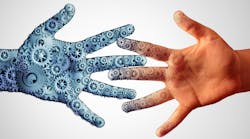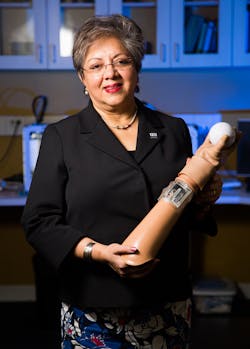Prosthetic hands have made impressive strides in recent years. 3D printing and advanced motion controls have made them easier to produce, more responsive, and accurate. A recent announcement made at the annual meeting of the Society of Neuroscience revealed that a person was fitted with a neural enabled prosthetic hand (NEPH). This marks the first time a NEPH will be used outside the laboratory in a real-world, everyday environment.
NEPH systems are different than most electrical signal-sending prosthetics. Traditional motion-enabled prosthetics are able to send electrical signals from the muscles to the drive motors to open and close the hand. NEPH systems work in a bidirectional system that stimulates small groups of sensory fibers in the user’s peripheral nerves which provide the sensation of feel and touch. This allows the user for the first time to feel when they open their hand or how firmly they grasp an object.
James Abbas is a researcher at Arizona State University (ASU), which is part of a larger multi-institutional research team that has developed the new prosthetic hand system with a fully implanted and wirelessly controlled neurostimulator. Abbas is an associate professor of biomedical engineering in the Ira A. Fulton Schools of Engineering and began his work with lead investigator Ranu Jang, professor, and chair of the Department of Biomedical Engineering at Florida International University (FIU), more than 10 years ago.
Ranu Jung, professor, and chair of Biomedical Engineering at Florida International University, displays the neural enabled prosthetic hand, which can provide the feeling touch to the wearer.
“Our system is the first one that is wearable for long-term use beyond the laboratory setting,” says Abbas, who directs ASU's Center for Adaptive Neural Systems and has expertise in neural engineering techniques and medical rehabilitation technology. “All of the components are either mounted on the prosthesis or implanted in the body. The system is familiar to him, as it is not that different from using and wearing a regular prosthesis, but now when he touches something he gets feeling in the phantom hand and fingers he’s lost.”
The work being performed at ASU builds on the research pioneered at the FIU research under professor Kenneth Horch. “The participant [of the NEPH] has reported enhanced confidence in performing daily tasks,” said Jung. “He is able to interact with objects around him and determine the answers to questions surrounding sensation, such as ‘Have I touched it?’ ‘How hard am I squeezing it?’ ‘How large and soft is it?’”
The U.S. Food and Drug Administration granted an investigational device exemption for the first-in-human trail to the NEPH system back in 2016. The participant of the NEPH had undergone a trans-radial-upper limb amputation and received the NEPH system in May 2018. The NEPH system is the first in a line of new advanced medical devices using similar neural-stimulating applications.
Abbas predicts a future where the same technology is applied to stimulate sensation to individuals with lower limb amputations. The team also hopes to contribute to the field of bioelectric medicine, which targets and stimulates and neurons to treat metabolic, digestive, and pain-related diseases.


